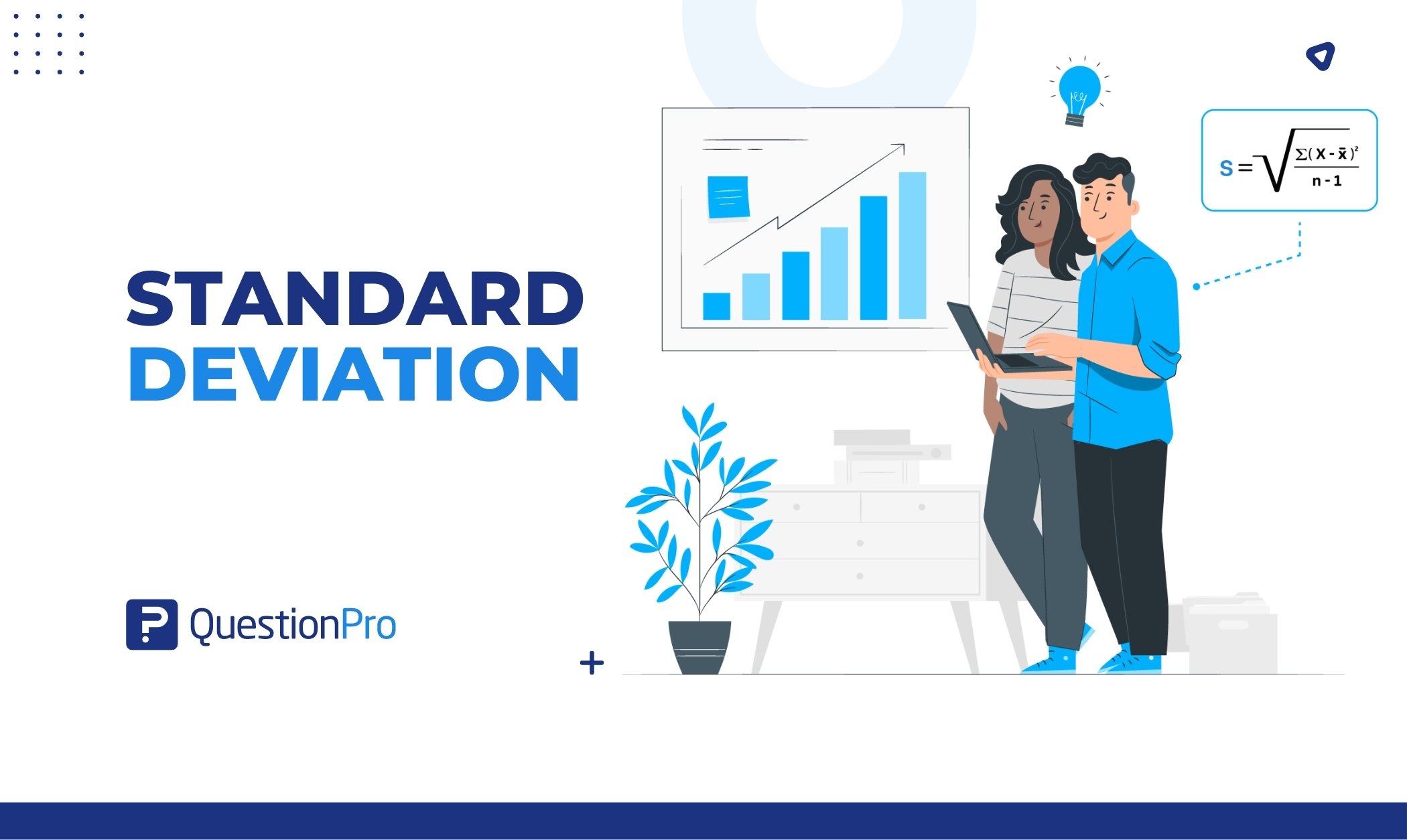
The standard deviation is one of the most important statistical measures used to calculate a research sample. It is also a measure of risk that analysts, portfolio managers, and advisors use.
In this blog, we will explain what it is, what it can be used for, and a step-by-step guide to calculate it.
What is the standard deviation?
The standard deviation is a measure of spread or variability in descriptive statistics. It is used for calculating the variance or spread by which individual data points differ from the mean.
A low deviance implies that the data points are extremely close to the mean, whereas a high deviance suggests that the data is spread out over a wider range of values.
In marketing, variance can assist in accounting for big variations in expenses or revenues. It also helps identify the dispersion of asset prices in relation to their average price and market volatility.
Importance of Standard Deviation
The standard deviation is an important metric in statistical analysis. Some of the reasons for this include:
It includes all observations.
One good thing about bias is that every piece of data is taken into account in the research. Other ways to measure deviation, like range, only look at the far-apart points and don’t consider the places in the middle. Because of this, the standard deviation is often seen as a more accurate and reliable way to measure than other data.
It can be used in combination.
Using a certain method, the standard deviations of two sets of data can be added together. There are no methods like this for other observational measures of dispersion in statistics. Also, unlike other ways of observing, it can be used in other math calculations.
It tells us when a set is unequally distributed.
Deviance is very beneficial when determining how unevenly your data set is distributed. It not only tells you the breadth of your data but also its unequal distribution.
It supports mathematical and statistical analysis.
The standard deviation value is always set and well-defined, allowing for both mathematical and statistical analysis.
It enables us to determine the risk of an investment.
The number of data points that depart from the mean can be used to calculate an investment’s risk. The greater the deviation from the mean, the more risky the investment.
LEARN ABOUT: Descriptive Analysis
The formula for calculating a sample’s standard deviation
The standard deviation is an important factor in determining the size of the research sample. The formula for calculating it is as follows:
Where,
- S = Standard deviation.
- ∑ = Sum of.
- X = Each value.
- x̅ = Sample mean.
- n = number of values in the sample.
Step-by-step Guide to Calculate Standard Deviation
Follow these steps to calculate a sample’s standard deviation:
Step 01: Collect your data
Collect the dataset for which the standard deviation is to be calculated. Assume you have a data set (45, 67, 30, 58, 50) and a sample of size n = 5.
Step 02: Find the mean
Calculate the sample mean (average) by adding all of the data points and dividing by the sample size n.
- Sample Mean x̅ = (45+67+30+58+50)/n = 250/5 = 50
Step 03: Calculate the differences from the mean
Subtract the sample mean (x̅) from each data point (X).
Difference = X – x̅
- 45, difference = X – x̅ = 45 – 50 = – 4
- 67, difference = X – x̅ = 67 – 50 = 17
- 30, difference = X – x̅ = 30 – 50 = – 20
- 58, difference = X – x̅ = 58 – 50 = 8
- 50, difference = X – x̅ = 50 – 50 = 0
Step 04: Square the differences
Square each difference acquired in the previous step.
Squared difference = (X – x̅)2
- 45, Squared difference = (X – x̅)2 = (45 – 50)2 = (- 4)2 = 16
- 67, Squared difference = (X – x̅)2 = (67 – 50)2 = (17)2 = 289
- 30, Squared difference = (X – x̅)2 = (30 – 50)2 = (- 20)2 = 400
- 58, Squared difference = (X – x̅)2 = (58 – 50)2 = (8)2 = 64
- 50, Squared difference = (X – x̅)2 = (50 – 50)2 = (0)2 = 0
Step 05: Sum the squared differences
Add all the squared differences together.
∑(squared difference) = ∑[(X – x̅)2]= 16 + 289 + 400 + 64 + 0 = 769
Step 06: Calculate the variance
To get the variance, divide the sum of squared differences by (n – 1).
- Variance (S²) = Σ(squared difference) / (n – 1) = 769/4 = 192.25
Step 07: Calculate the standard deviation
Finally, calculate the standard deviation by taking the square root of the variance.
- Standard Deviation (S) = √variance = √ 192.25 = 13.875
LEARN ABOUT: Statistical Analysis Methods
Uses of the Standard Deviation
The standard deviation is a useful statistical measure that has several uses. Here are five common uses:
01. Measure investment risk
Many investing companies utilize the standard deviation to determine how far the fund’s performance deviates from the expected return. This data may be communicated to end users and investors because it is simple to understand.
In this way, the deviation allows us to measure the riskiness of market securities and forecast future performance patterns.
02. A better understanding of the data sets
It is used to calculate the spread of values in a data set. Individuals and businesses utilize bias all the time in various sectors to better understand data sets.
03. Understand ad performance
Marketers frequently calculate the standard deviation of revenue earned for each ad to understand the revenue fluctuation to be expected for a given ad.
You may also calculate the variation in the amount of advertising used by competitors in this area to see whether they are utilizing more or fewer ads than usual during a certain period.
04. In human resources
The recruiting manager’s responsibility includes calculating the standard deviation of pay in a certain field in order to determine what type of salary variation to provide for new hires.
LEARN ABOUT: Average Order Value
Conclusion
The standard deviation is a useful statistical measure for determining the variability and dispersion of data points within a dataset. It is frequently used in a variety of fields for a variety of objectives.
Standard deviation describes data variability, assesses risk and volatility, monitors processes, evaluates performance, and supports hypothesis testing and statistical inference by quantifying the dispersion of data around the mean.
QuestionPro is a popular online survey and research platform that offers a variety of tools and capabilities for creating, publishing, and analyzing surveys. It has an easy-to-use interface, a variety of question types, customization possibilities, and powerful reporting tools.
QuestionPro can be used to collect data for analysis and to calculate statistical measurements such as standard deviation. To obtain responses from participants, researchers and analysts can develop surveys utilizing Likert scale questions, rating scales, or other data collection approaches.
Users can efficiently collect data, including the information needed to determine standard deviation, and further examine patterns, trends, and relationships within their data by using QuestionPro in the research process.







